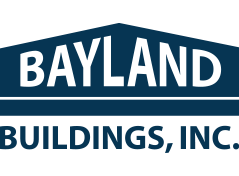Bayland Buildings, Inc. & GEA breaks ground on 72-stall rotary robot
CASHTON, WI - Officials from GEA Farm Technologies and Bayland Buildings, Inc., broke ground today on a 72-stall all-robotic rotary parlor on Nick Mlsna's farm near Cashton, Wis., an hour east of La Crosse.
It will be the largest rotary robotic milking system in the world, and a first for North America, says Matt Daley, GEA CEO. GEA robotic rotaries are currently operating in Holland, Germany and the United Kingdom, with sizes ranging from 40 to 60 cows. "The application of this technology on such a large operation has not been done anywhere else in the world and for most every dairy farmer in America, this is quite significant," he says.
Mlsna, who dairies in partnership with his parents, Dennis and Barb, his wife LeAnne and their four children, says the installation represents a significant step forward in both farm size and technology. The Mlsna's currently milk 900 cows through a double-12 parlor. "The current parlor (built in the 1990s), is pressured with cow flow and we struggle to stay on schedule milking 900 cows three times a day," says Mlsna.
The Mlsna's currently employ 21 employees, milking 3X with a three-person crew working each eight-hour shift. The Mlsna's hope to retain all 21 employees after the expansion, but milk more than twice as many cows. The expansion will take herd size to 2,000 cows with the addition of the parlor and a 330' X 520 cross-ventilated barn.
The new parlor will have a robotic arm at each stall, which will disinfect udders, prep teats, attach units, milk, post dip and sanitize the units after each milking. Larry Ferguson, with Advanced Dairy Solutions, the Mlsna's GEA dealer, says one person will still be needed in the parlor to monitor cow flow and milkout. But that will be less than the four or five milkers most 72-stall rotaries currently use. Plus, teat sanitation, stimulation and attachment should be much more consistent with the robotic milkers.
Neither Mlsna nor Daley would comment on how much the robotic system adds to new parlor costs. "But the cost will be substantially less per stall than the box system robots currently on the market," says Daley.
Those conventional units can cost up to $200,000 each, depending on how many robotic boxes are installed. Each is designed to milk up to 60 cows per day. With eight minute rotation times, the rotary robot could milk similar numbers of cows per stall per day with 3X milking.
Labor cost savings should be substantial, says Daley. With milking labor costing $13 to $15 to $18 per hour in some areas, eliminating the need for two to four milkers per day year round will add up quickly, he says. Plus, the robots will do a much more consistent job of teat disinfection and udder prep than human milkers working eight hour shifts. Plus, abnormal milk detection through color screening and in-line milk conductivity testing also should be much better.
Though the official ground breaking for the facility was done today, substantial earth moving and site grading has already been going on for several weeks. The first concrete for the next facility should be poured in early September. Construction crews hope to have the building enclosed before the snow flies, and the first cows should be milked in the facility in March 2015.





